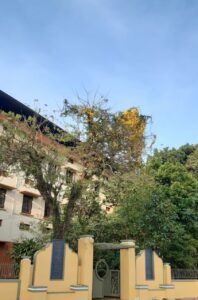
“A garden is a grand teacher. It teaches patience and careful watchfulness; It teaches industry and thrift; above all, it teaches entire trust” – Gertrude Jekyll
Hortus Venad, The Botanical Garden of Sree Narayana College Kollam(BGSNCK) is a space of serenity on the campus offering an array of wide varieties of flora. This green scape not only offers a visual treat to the visiting public but also serves to seek the avid attention of environmentalists and botanists. Furthermore, it also imparts awareness of the flora, its propagation and conservation, thus highlighting a message of eco-consciousness. It is significant enough to state that it abides by the policy measures stipulated in ex-situ conservation.
Brief history
Tracing its origins in 1975, Hortus Venad, then popularly referred to as Unicom Gardens, covers an area of 0.05 ha. Initially, Prof. N Ravi gave the idea of building the teaching garden. Later, Prof. PN Muraleedharan, former Head of the Department of Botany, took great initiative to build a Plant conservatory (greenhouse) in the middle of the garden with the help of a Commerce Alumnus during the 2000-2001 period. During 2016, it underwent upkeep involving the planting and nurturing of native shrubs and trees as part of renovation works. In 2022, the college management and PTA made serious efforts to revamp the garden effectively and construct an information-rich compound wall.
The following is an enlistment on the further details of this botanical scape:
- Consists of 183 species of vascular plants, which includes 147 species of Angiosperms, 32 species of Pteridophytes, and 2 species of Gymnosperms.
- Among the flowering plants (Angiosperms), 72 species are trees, while 81 species are Exotic plants.
- Dominant plant families are Fabaceae and Euphorbiaceae.
- 21 plant species belong to the IUCN Red List category
- 16 species of the Western Ghats endemic plants
- A preliminary study conducted here identified 23 butterfly species. ~ BIS Report, 2020
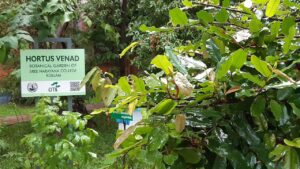
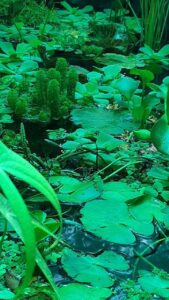
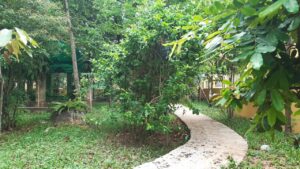
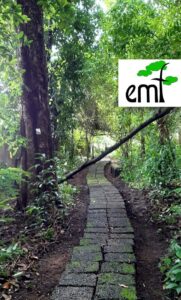
Sections @ Hortus Venad
-Arboretum: Main attraction of the garden, named Essencee Mini Forest (EMF) in commemoration of the International Year of Plant Health 2020, is a collection of about 60 tree species, which come under Indigenous / RET / Exotic categories
-Fernery: Collection of 32 species of Pteridophytes
-Shrubbery: Collection of 22 species of shrubs and woody climbers
-Aquatic Garden: 15 species of water plants & 3 species of fishes
-Med Plants Conservatory: 61 species of medicinal plants
Herbarium: An associated division (acronym SNCH), recognized by International Herbarium Index, housed about 5000 dried plant specimens, which belong to 2050 species of voucher specimens, especially from Flora of Sree Narayana College Kollam, Flora of Kollam District, Flora of Pathanamthitta District.
Major attractions
- Barringtonia asiatica (L.) Kurz, ‘Fish poison tree’ / ‘Box fruit tree’/ നീർപ്പേഴ് (Family: LECYTHIDACEAE) : Planted at BGSNCK in 1978, from the live collection of Andaman & Nicobar Islands. All parts of the sp. are poisonous, due to saponins. Its characteristic ‘Box’ fruits are potent enough to be used as a fish poison. The seeds are ground to a powder and used to stun or kill fish for easy capture, suffocating the fish while the flesh is unaffected. The species is treated as a “flag species” of the EMF
- Aquilaria malaccensis Lam., ‘Agarwood’ / ഊദ് : Valuable resin is produced by the tree in response to infection by a parasitic fungi Phaeoacremonium parasitica, used in incense, perfume, and carvings. According to IUCN Redlist status, the species is considered as ‘Critically Endangered’
- Cananga odorata (Lam.) Hook.f. & Thoms., ‘Queen of perfumes’ / ‘കനക ചെമ്പകം’ (Family: ANNONACEAE):- Source of valuable essential oil ‘ylang-ylang’, is widely used for its analgesic properties that help relieve headache pain due to its ability to penetrate through nerve cells in the brain easily.
- Dolichandra unguis-cati (L.) Miers., ‘Cat-claw vine’ (Family: BIGNONIACEAE): A curious heat-loving climber, planted in 1996, climbs with the help of ‘cat-claw’ like tendrils into the top of the trees. This specimen is usually given for practical study classes on anomalous secondary thickening under UG & PG programmes.
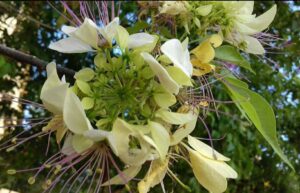
- Creteva religiosa G.Frost, ‘Temple plant’ / ‘നീർമാതളം’ (Family: CAPPARACEAE)
- Aglaia elaeagnoidea (A.Juss.) Benth., /’droopy leaf ‘/ ‘പുണ്യവ’ (Family: MELIACEAE)
- Citharexylum spinosum L., ‘fiddlewood tree’/ ‘പാരിജാതം’ (Family: VERBINACEAE)
- Santalam album L, ‘Indian sandalwood’/ ‘ചന്ദനം’ (Family: SANTALACEAE)- Endangered
- Carissa carandas L., ‘Carandas plum’ / ‘കാരപ്പഴം’ (Family: APOCYNACEAE)
- Cinnamomum verum Presl, ‘Cinnamon’ / ‘കറുവപ്പട്ട’ (Family: LAURACEAE) – Vulnerable
- Chrysophyllum cainito L, ‘Golden leaf tree’ / ‘സ്വർണപത്രി’ (Family: SAPOTACEAE)
- Bridelia retusa (L.) A. Juss., ‘Spinous Kino tree’ / ‘മുള്ളുവേങ്ങ’ (Family: EUPHORBIACEAE)
- Garcinia gummi-gutta (L.) Robs., ‘Malabar camboge’/ ‘കുടംപുളി’ (Family: CLUSIACEAE) – Vulnerable
- Guazuma ulmifloia Lam., ‘Bastard Cedar’ / ‘ഭദ്രാക്ഷം’ (Family: MALVACEAE)
- Saraca asoka (Roxb.) Willd., ‘Asoka tree’ / ‘അശോകം’ (Family: FABACEAE) – Endangered
- Terminalia bellirica (Gaertn.)Roxb., ‘Myrobalam’ / ‘താന്നി’ (Family: COMBRETACEAE)
- Carallia brachiata (Lour.) Merr., ‘Fresh water mangrove’ / ‘കരകണ്ടൽ’ (Family: RHIZOPHORACEAE)
- Ficus mysorensis Roth , ‘Mysore Fig’ (Family: MORACEAE)
- Vallaris solanacea (Roth.) Kutze, ‘Bread flower’ / ‘വിഷപ്പാല’ (Family: APOCYNACEAE)
- Olea dioica Roxb., ‘Rose sandalwood’ / ‘കരിവെട്ടി’ (Family: OLEACEAE) –
- Caryota urens L., ‘Elephant’s palm, Toddy palm / ‘ആനപ്പന’ (Family: ARECACEAE)
- Polyalthia suberosa (Roxb.) Thwaites, ‘Corky debar tree’ (Family: ANNONACEAE): Larval host species of ‘Tailied jay’ butterfly
- Araucaria heterophylla (Salsb.) Franco, ‘Star pine’ (Family: ARAUCARIACEAE)
- Zamia furfuracea L.f, ‘Cardboard palm’ (Family: ZAMIACEAE)
- Diplazium esculentum (Retz.) Sw., ‘vegetable fern’ (Family: ASPLENIIAEAE): Fried young fronds are used for making salads.
See the updated Checklist on the flora of ‘Hortus Venad’ at BIS Report (March 2023)
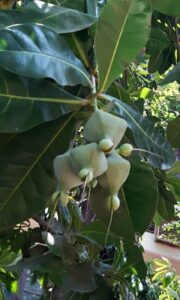
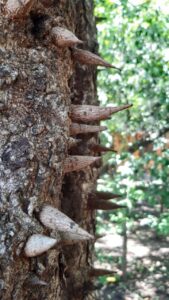
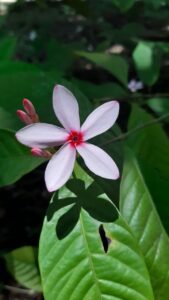
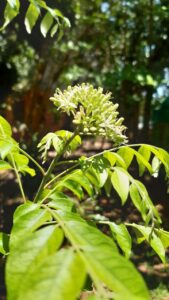
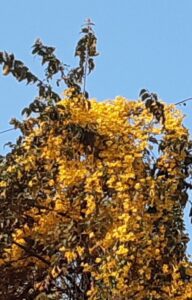
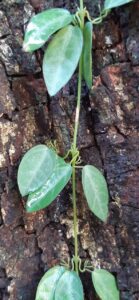
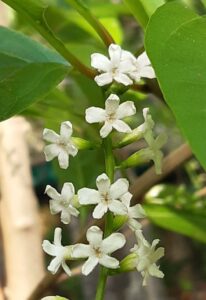
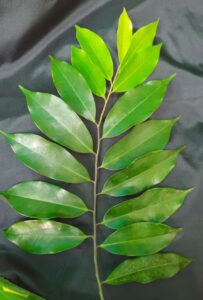
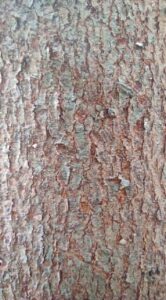
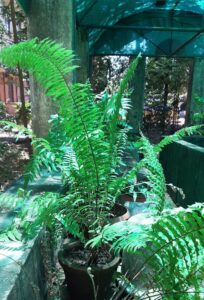
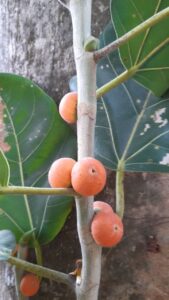
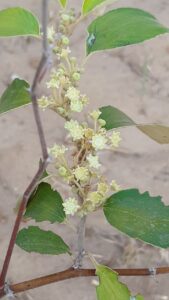
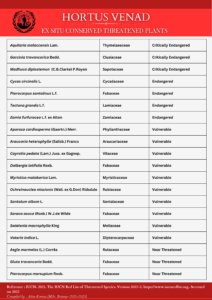
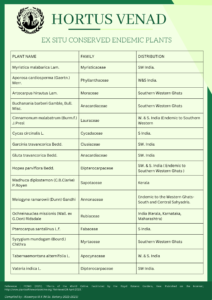
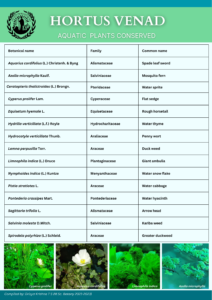
Affiliations: Department of Botany, Urban Garden of SNCK, Botanical Information Service(BIS), Sree Narayana College Herbarium(SNCH), GRASSNEST
____________________________________________________
Prepared & photographed by Dr KIRANRAJ MS (last content revision 01 April 2023)

